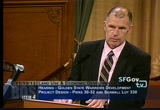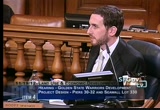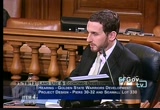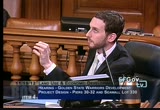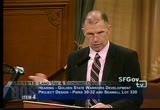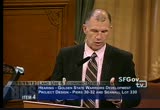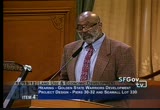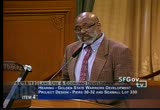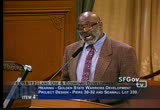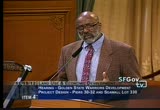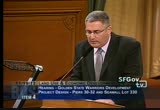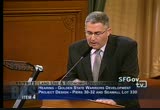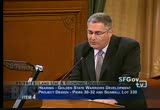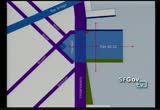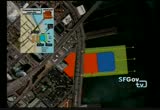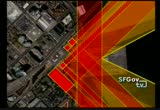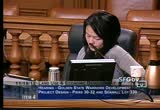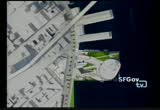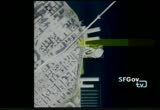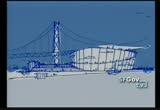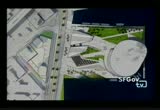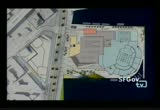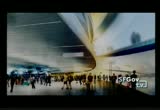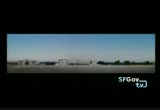tv [untitled] December 1, 2012 9:30am-10:00am PST
9:30 am
fertile ground to work with. >> and just one more question. i know some people, and including in the plans, brought up the concept of water taxis and ferries. that can be an advantage of the site. and given, of course, we anticipate a lot of fans, others, participants from the east bay, that could be one way to kind of increase public transit, but also mitigate some of the concerns about crowd control after games as they're heading back the other way directly off the pier onto ferry boats. what is the realistic nature of those types of alternatives and how can we begin to explore them? >> thank you. so, for the transit, classic transit service, golden gate, the boat pro supplieders that take you to the ball parks, they carry about a third of the transit rider ship already at the ballpark. that is a tare men disamount of lift. it is much higher than the representation of the commuters downtown.
9:31 am
water taxi is a new animal. the port just finished the fee process. i was on the water taxi with the bidders because i wanted to see what value they could add specifically for america's cup. my brain doesn't stop therethv i wanted to look atwater taxi as a resource. [speaker not understood]. i want to talk to them more extensively about next year. this gives us plenty time what water taxis mean by the time it is open in 2017, 2018. >> thank you. i just want to say i think this is a truly critical part of this development as we move forward and i appreciate the work that is happening in this area. i know that supervisor wiener has some questions, but i just want to make sure that we continue to look at this, one of the top concerns of course are we going to be able to [speaker not understood] to meet this need and how do we serve it, but also not impact other parts of the city as well. and then how can we also enhance some of the existing issues that already exist in the neighborhood even without the warriors arena that have
9:32 am
safety issues, the bike access as well as other public transit. you i really look forward to working with you and the mta as we move forward with this. i believe supervisor wiener has questions as well. * >> thank you, mr. chairman. thank you for that presentation, mr. albert. very much appreciate it. the plan seems like solid in many ways but in the linchpin to all of this is muni. i'm hopeful to have a great water taxi system even better, better and berry ferry system. hopefully the cpuc won't kill off the uber and other kinds of innovative car sharing services and we'll be able to have that and better biking and pedestrian. really at the heart of this is muni. and i guess my question for you is putting aside sort of the grand planning and vision, what level of confidence do you have by the time this arena opens, muni is actually going to do
9:33 am
what it needs to do to invest in a system and expand the system and be able to actually service this? because this is a lot of [speaker not understood]. i'm very supportive of this project. i think it could be a really, really great thing for san francisco. but i do have concerns about whether muni will actually be able to in a very tangible way invest in the system, make it more reliable and expand the system to allow this to work. i mean, we've seen, for example, in terms of muni's toke of light rail vehicles, a whole hearing on this this morning, it has typically -- you need 114 to operate and typically has 114 functional. so, if one goes out of service, there is usually nothing to replace it. we've seen in my district the upper market area where we're adding thousands of units of new housing and our subway capacity is inadequate to meet current demand. and i keep promising my
9:34 am
constituents that, don't worry, muni is on it. we're going to be working very hard and expanding service and making it more reliable. but at some point it starts to ring hollow. so, i want this to succeed and i don't want it to be a transportation nightmare. and i think for that to happen, muni has to be able to invest and expand. and right now i don't see that. and i think very highly of current muni management. but i think we just don't see the level of investment that we need for a growing system. so, i'd be curious to know your thoughts on that. >> thank you. as a constituent of the district when somebody gets passed by trains are too crowded by the time you get to church street, i would be the first person [speaker not understood] when it comes to working with my management if there wasn't a level of commitment. here's what i can tell you. at america's cup we learned what we can do. we have a team, a system that is going to be incidental or
9:35 am
instrumental to managing loads that are above and beyond extraordinary. i think that is one of the big concerns if we have an arena and ballpark and new development at pier 70, clearly there are going to be demands on the system that are bigger. >> if i can interject and i'm sorry to interrupt. i think mta did an outstanding job around the america's cup and whatever -- the 12 things were happening in the city the same day. absolutely outstanding job. that is a very unique and singular situation. america's cup is not a great comparison because it's specific dates. it's not many days a year every year into eternity. and, so, i think this is much more about the structural day-to-day operations of muni. >> thank you. that's where i was going. so, when we did this episodic heavy lift, we learned there are going to be things hard to sustain. why do we not do this kind of service all the time? what are the capital shortcomings of the system that make it hard for us to run the
9:36 am
e line and augment the others? what are the operational challenges? because to get a bunch of operators in for a big day is one thing. how do you sustain that, how do you train the drivers in advance? how do you have a graduating class well before the demand? this year a few things given me a greater sense of confidence. we worked on this and did some of the planning at the hunters point shipyard. to procure the streetcars we need, we need them three years in advance of when they should be running. we have to order streetcars so we have bigger capacity, we have to be three years ahead of the implementation of the project. so, we've embedded now in the procurement cycle the extra streetcars we need working with the capital program. he knows what the model will tell us. he'll put it into the capital program and then we'll have a fleet, not the order when they're needed to run, but the order tested, the streetcars and actually running on the street. the cost of the infrastructure itself, the rail, the rail switches that help the e he line work not just when there is a big day but around the clock, those are real switches
9:37 am
that make it easier for drivers to not have to get out of the trains and flip the switch and get back in the train. those are embedded not necessarily extensive, but they need to be part of the capital program. there is a whole spreadsheet of all the operational capital investments that are needed to get this level of service not just for an episodic thing, but for really the quality of the whole waterfront. that is part of our assessment. and a lot of that [speaker not understood] america's cup because we pushed up against the capacity of the system. that tells you we're paying attention to what the shortfall is between an episodic thing and permanent. >> absolutely. in terms of the planning and the thinking, what you're doing, i think it's all very best of the best. [speaker not understood] -- i'm not convinced -- i want to be convinced muni will do what it needs to do and stay focused for a sustained period of time
9:38 am
on improving and expanding service. >> just to conclude that, i had meetings with john haley next week. he's going to help me with the service planning. he's going to know the full range of it. the trick of this assessment is that not all the impacts are going to happen in the next year or next few years. so, we do have to measure up with the milestones when a certain development opens. [speaker not understood] we're not just paying attention to the waterfront projects. we're looking at the transbay transit center. we're looking at all other a big demands. it would be wrong for us to be claiming for capacity improvements just on the waterfront when so much is happening one block inland. do share your confidence with the administration. i've worked with muni long enough to see the different responses that come out of these demands, the teams, input in command that report back to capital and say if you want to do this all the time, you need to think about this salient piece of infrastructure or this sorely needed upgrade over there. that is a conversation that is happening at mta. * i'm certainly helping shepherd
9:39 am
in this direction. >> thank you. >> thank you. >> supervisors, [speaker not understood] with port. the planning development division there. i want to briefly provide the planning context for the design presentation that you are about to see. as you know, the port owns the -- most of the waterfront property on the bay from fisherman's wharf do you rememberctionv to india basin and the bayview. in 1997 waterfront land use plan was adopted, the first waterfront land use plan for the port after a multi-year process. community planning process to develop -- to determine what the uses would be for that property, what kinds of uses would be acceptable and unacceptable for that 7-1/2 miles of waterfront property that we own and manage on
9:40 am
behalf of the state. the main thrust of that waterfront land use plan was determining what the port priority uses would be, specifically in the maritime uses for the various subareas. there are five subareas within the waterfront land use plan. it also focused on park and open space systems as well as creating mixed use development, opportunity areas for each of the five -- each of the five subareas. i should mention again one of the primary thrust of the waterfront land use plan was reconnecting san francisco with its waterfront. when that plan was adopted, working with city family, the city's general plan and planning code were amended so that the policies including design review process within the
9:41 am
plan were in keeping with the waterfront plan. as you know, the bacon certification development commission has plan districts, basin property as well. their master plan, their bay plan after the waterfront land use plan was amended -- was adopted, their bay plan was also amended so that policies could be aligned. and also to make sure that there was a robust design review process and that design review process is a joint process between the city and dcdc. specifically the south beach sub area anticipated a number of uses, but more importantly, it anticipated large scale waterfront attractions like
9:42 am
sports facilities, like the perez presentation you're about to see. specific to pier 30-32 and seawall 330, the site of this proposal. * piers 30-32, the plan anticipated entertainment and assemble uses, commercial activities, public open space, maritime and water dependent uses, the kinds of elements that you'll see within the presentation that are about to be presented. as it relates to seawall lot 330 on the west side of the embarcadaro, that seawall lot was anticipated within the plan as a transition from waterfront uses to the kinds of uses, residential uses in the south beach community. so, that site, seawall 330, anticipated residential, hotels, those kinds of uses in addition to commercial activities.
9:43 am
i wanted to note as it related to the immediate context. the adjacent facility, [speaker not understood] adjacent to the site are developed with sheds, bulkhead buildings, and the waterfront plan specifically mentions that there is an opportunity in its large vacant site to develop new waterfront architecture that could be complementary to the historic facilities adjacent to it, but could be a departure from these 100-year old buildings that occupy piers 26, 28, 38, and other adjacent piers. so, with that brief introduction or brief reference to the waterfront plan, wanted to introduce the next speaker, ken rich, who is going to talk
9:44 am
specifically about the context for this design. >> good afternoon, supervisors. ken rich, ouwd. this is a brief introduction to the main event, which is craig dikers. first, we want to thank everyone involved,edth warriors, design team, large city staff team, and most importantly the cac and the community at large for working with us to develop and respond to a design concept in what has been a very short period of time given the magnitude and complexity of the project. and second, we want to make it clear that even though as you will see, there is a ton of work and thought, there is obviously put into the design so far, we are very early in the process and there will be a lot more evolution over the next year. so, by way of a brief introduction to the concept itself or the design itself, please keep in mind that this is a concept, not a finished design ferment however, pretty some of the pictures look, this is a concept. that means it's more about at this stage the function of the
9:45 am
sites, use kind of a prosaic word, the shapes, the materials of the building are not proposed yet. basically today we would ask you to focus on whether the proposal succeeds in meeting the basic goals that we have for a development on this site. these were developed early by staff and discussed with the community at early cac meetings. let me suggest a few questions to keep in mind, if i may, as you watch the presentation. so, for the piers, the proposal succeed in offering a variety of different kinds of assets to the water and water-related activities? does the proposal maximize usable public open space? does it [speaker not understood] public or private? does the proposal preserve or even enhance the most important views of the water and of the bridge? and that is not all views which would be impossible, but the key most important views. so, if the proposal [speaker not understood] mass of the arena building and parking
9:46 am
structure, does the proposal set up pedestrian and auto circulation in such a way that they don't conflict with each other or jamb up the streets? all in all, on the piers, can you imagine the proposal for the pier actually adding value and beauty to what is already a pretty spectacular location? and then quickly for the other side of the street, the seawall lot, sort of the set of different criteria, does the proposal feel like a part of the city and the neighborhood? does the proposal help create an appropriate edge to the city as it meets the water? does it come down to the street at a human scale along the embarcadaro? does it offer transparency, in other words, views into the shop or the lobby from the sidewalk? is the edge along the embarcadaro aligned with active uses and does it feel comfortable to walk along the embarcadaro? in term of the higher buildings proposed on the seawall lot, do they preserve important public view corridors? and lastly i'd like to go ahead
9:47 am
and introduce craig dikers, the lead designer of the architecture firm, to take you through the design proposal. tanks. -- thanks. >> thank you very much. thank you, supervisors, and audience. it's an honor and a privilege to present some of our ideas and developments that we've had to date. and as mentioned earlier, we're still in a very preliminary stage of the work. and we hope our design will be seen as providing a clear conceptual development around which variations to the design can develop over time as we have more feedback from the community and from those invested in the project. the first thing to point out to you in this first slide are some of the basic principles that define our way of thinking. as you can see, there is the blue swath that covers both pier 30, 32 and the seawall side and that is because we understand both of these developments to be integral with one another and to have -- and provide a similar sensibility, although
9:48 am
complementary as you move along the embarcadaro. you'll also notice that on each side of the pier site you'll see slightly different colors. that is because we want every edge of the pier to be responding in a unique way to its unique conditions. it is a very, very large pier site. so, one would imagine that each of the edges of it would have a different condition. so, along the north side nearest to pier 28, a more urban quality to that side of the pier. to the east side, the width and breadth of the pier over looks the very broad areas of the bay and of the water and coast lines beyond towards oakland. we want to provide a large views and connected views and movement along the east side of the pier. then to the south adjacent to the new street wharf project, we want to create a more recreational low rise atmosphere, the best response to these new developments by the city and to the west. alongside the seawall sites, we want to have a scale that's intimate with the embarcadaro
9:49 am
and that is responsive to the cultural traditions that most people recognize along the embarcadaro. you'll also see squares, there is a little square up there that's red. that is the location of reds which is one of the structures on the site. and there's been another blue square off to the left that is the water mark residences that are part of the adjoining sites here and we're trying to take care of their interests as we develop the project further. you maybe have seen some images of this site in the past. this is one of the views taken from a newspaper article showing a earlier understanding of what might be built here and essentially the arena was placed in the center of the site. maximizing large areas of open space towards the east side. the challenge with such a design is that it blocks views rather tremendously from many of the surrounding areas and certainly changes the context of the waterfront that people have become accustomed to here. our project has been focused on looking at not only the private
9:50 am
views, but also the public views in and around the site. these are some of the view corridors that we studied from the existing buildings. and you can see here pushing them all together sort of basic understanding of what impacts the arena and the largest mass of the arena would have on these surroundings. there is an area that is more or less open out towards the edge. and we found that by placing a building there, it would also diminish the impact of views and experience along the embarcadaro. so, this is where the pier is based centrally as you might have seen it in the past. this is moving it out and rotating it slightly so it falls into a zone which we feel has least impact more towards the east than originally anticipated. now, there are a number of other concerns about these view corridor studies of seawall. i'd like to address those in a moment.
9:51 am
for the meantime i'd like to say these corridor studies are important to the arena itself. there is a very large structure and will have certainly the most impact on the surroundings, more than the structures that are anticipated in building here. >> before you move on, if i can ask the question, because it's come up with some of the our residents [speaker not understood]. can you go over which sites you've examined and how you chose those sites? clearly the first one is the water mark, but if you could -- [multiple voices] >> yes. each of those sort of orange blocks that you see filled out are the immediate adjacent sites as well as the public view spaces. so, we have two sets on the top which are on bryant street. those are immediately adjacent to the site and have open views currently. then just to the south are the buildings along beale street and then in the middle is the water mark. then the large swath that runs really north-south is basically
9:52 am
a zone that is the public space related to the embarcadaro as you move up and down. and you'll see this view study again in a moment related specifically to the seawall site. this right now is just focusing on the mass of the arena, which is quite a substantial building. and, so, it's the first step we took. >> thank you. >> and as we move further you'll see the basic design as has been developed until the site plan and an arrangement for the structures. you'll see the arena placed far to the east as possible, removing its mass from the embarcadaro, and open space plaza in between and just to the west of the arena and the multi-purpose facility that connects to a retail venue which is along the embarcadaro proper. and we'll talk more about that retail structure in a moment. then across the street is a seawall site which has currently a low level podium, basically in the range of the podiums that exist today. and then some more dense
9:53 am
structures slightly taller or taller atop that podium. and we'll address that again in just a moment. one of the views of the site from the distance shows how the arena and the multi-purpose venue itself will reach out into the water and create an interesting focal point along this portion of the waterfront that is essentially today an open space in between giants stadium and the financial district and the bay bridge itself. one of the other views, studies that we did was simply from public spaces. so, this is a view from an area that is essentially where main street reaches down to bryant street. today that's a lesser known street. but in the future when transbay terminal is built, one will imagine that street will be more pedestrianized than it is today. and also we'll see more traffic moving, pedestrian traffic moving down this corridor. so, we wanted to make that view and the view between pier 28
9:54 am
and pier 30 a unique view and we wanted to preserve the types of finger pier type spaceses in this particular slot. so, the buildings are of similar height along that edge. additionally as you move from main street proper looking out as you come down the hill, you know that's a very, very steep hill right there. so, if you just look on the map and you see it as flat, you think, well, you can never really see anything anyway. in fact, it's quite a steep hill. as you're coming down the hill you will have views from main street out over the water that we wanted to protect. and once again, moving the arena and multi-purpose facility to the east allowed us to do that. and also you'll see our current designs for the seawall side allows us to do that. from the embarcadaro proper, we're trying to preserve as much as possible the wide view out to the waterfront. it's not perpendicular to the waterfront as it is today. we're preserving that corner with low rise, structure is low, that will allow passersby
9:55 am
to see out to the bay. finally, really interesting view that we're working with as you move north from giants stadium and from areas south of south beach, you'll be looking towards the bay bridge pier. this is one of the few locations where the bay bridge first pier is really visible and we wanted to highlight that in the new design. here is the first sketch that we have of the concept, sort of the arena to the east. retail low rise to the left. enormous space, this wonderful space that frames the view of this pier, which is really one of the most dramatic components of this part of the city and certainly of the neighborhood here. these are some later sketch renderings that we've made. these are very early. i did want to mention that we have not yet really resolved the facades and the finishes yet. it's still too early. buts as will be noted in a moment, we are looking at transparent grass facades for the arena so people can see in and out of the activities there as they move along the
9:56 am
waterfront. * glass this is moving closer. you can see this is from the new park looking towards the piers and the bridge. and once again, by framing this view, you're really characterizing the drama of this unique spot in the city. this is a later sketch. all of these are still really sketches from where we had hoped and are hoping to provide some direct access to the waterfront for human-powered boating as well as other marine activities as you'll see also in just a moment. this is a detail of the site plan. and just to mention to you, one of the key features here, this plaza that's in between the arena and the retail is actually raised so you'll see a series of ramps and steps leading up to that. and that brings you up to the level of the entrance into the arena and allows for views of the harbor front in a unique way slightly above street level because we want people to be able to see the water from different levels, different
9:57 am
perspectives which we think will be exciting. this is a very draft plan of the ground level. one of the things that we'd like to point out is that the northeast corner, you see that sort of empty blue square, that's a multi-use community facility as well as a basketball practice facility that can be used at different times for different purposes on that corner. we've also pulled the building back from the corner to allow for more open space along the edges of the water so people can stop there and enjoy the views and activities along the waterfront directly. we've pulled all of the support facilities into the arena as far into the core as we can. if you see there is a gray spot in the middle right next to the blue with a bunch of parks in it, that's where the loading dock s. so, we've pulled the loading dock deep into the project so it will have as little impact on the surroundings as possible. the parking area that we are obliged to provide is also
9:58 am
buried deep in the project so it's underneath this raised plaza and the raised plaza helps camouflage the sound and site of the parking to the neighborhood and the yellow off to the left there is the retail component. and just to the south you'll see an open park, low-rise access both to the arena and to the retail establishment. it's down at street level. inside the arena, as i mentioned earlier, we're promoting the use of glass at all the public areas as much as possible so that while you're in the large public concourses that lead to the seating areas, you'll be able to look out over the harbor and have these kind of amazing views of the city. likewise, you'll be able to see back into the arena when there are activities at night. we are looking to provide an open, sort of openly publicly accessible outdoor ramp that leads up to the side of the building that gives unique views of the harbor that cannot be found really anywhere else in the city. and the possibility we hope to plan for an observation deck
9:59 am
related to this ramp itself. the retail functions of the site are placed in a low-rise structures that are very much in the quality and appearance, esthetic of the original structures along the piers. so, they're about 60 feet high and they have the shed-like appearance that we're still developing. they'll have direct access from the embarcadaro. this is a view showing those retail facilities in relation to nearby pier 28. you'll see they're about the same height. so, there is no sort of wall or tower kind of structure on the west side of the embarcadaro. it's simply continuing the esthetic and mass of the existing facilities. >> mr. dikers, can we just ask you about those structures? >> sure. >> are they like shopping mall type retail, or what would be the purpose of those sheds? >> there's a number of functions that are being considered, certainly a range of functions all
86 Views
IN COLLECTIONS
SFGTV: San Francisco Government Television Television Archive
Television Archive  Television Archive News Search Service
Television Archive News Search Service 
Uploaded by TV Archive on

 Live Music Archive
Live Music Archive Librivox Free Audio
Librivox Free Audio Metropolitan Museum
Metropolitan Museum Cleveland Museum of Art
Cleveland Museum of Art Internet Arcade
Internet Arcade Console Living Room
Console Living Room Books to Borrow
Books to Borrow Open Library
Open Library TV News
TV News Understanding 9/11
Understanding 9/11